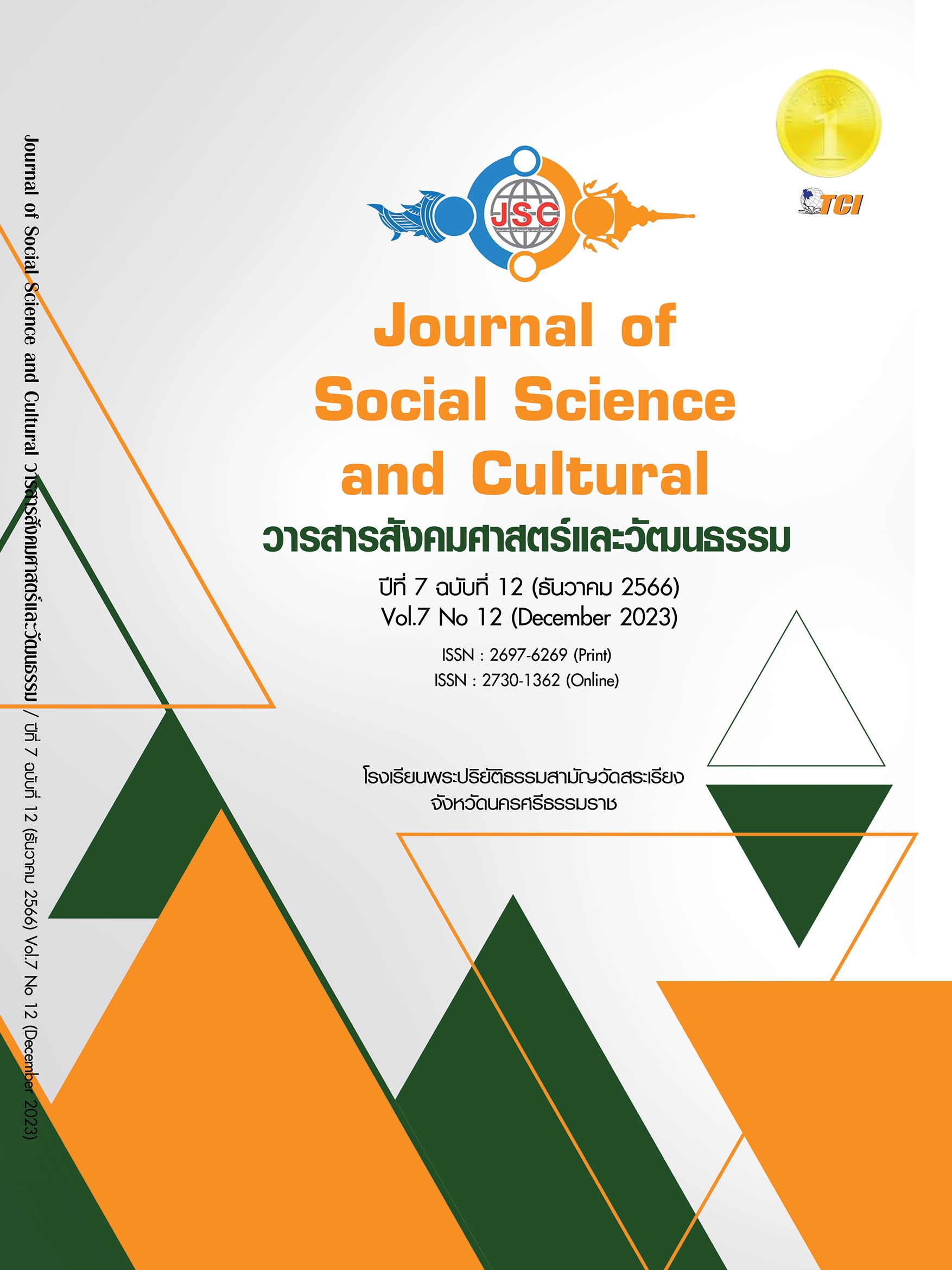ESTABLISHING A SOCIAL SUPPORT SYSTEM TO ENHANCE THE QUALITY OF LIFE FOR THE ELDERLY RESIDENTS IN BANG TAE, SAM PHRAN DISTRICT, NAKHON PATHOM PROVINCE
Main Article Content
Abstract
This research aims to 1) study the level of social support system development, 2) compare the levels of social support system development, and 3) propose a model for social support system development to enhance the quality of life for elderly residents in Bang Toei Subdistrict, Sam Phran District, Nakhon Pathom Province. The research combines data from 285 elderly individuals aged 60 and above in the specified area, as well as data from 14 community leaders, including 7 village elders and 7 volunteer health workers. Research tools used include interviews and questionnaires, and data analysis involves statistical techniques such as frequency, percentage, mean, and standard deviation. The research findings include: 1) The social support system for the elderly is perceived to be moderate overall ( = 2.72, SD = .794), with scores for social aspects (
= 2.86, SD = .743), mental well-being (
= 2.81, SD = .792), and environment (
= 2.76, SD = .814) in that order. 2) In studying the level of social support system development, statistically significant differences (p-value < 0.05) were found, indicating that the level of education did not affect the development level. However, age and occupation influenced general understanding. Those with higher education, typically at the bachelor's degree level or above, tended to have higher income and more resources. Support should be tailored to the needs and interests of the elderly, who often show interest in social activities. 3) The model for social support system development consists of multiple steps, making the project successful through flexibility and continuity. The five crucial steps for developing a social support system are: 1) presenting the project and objectives, 2) obtaining community and elderly approval, 3) presenting results and measuring success, 4) managing resources, and 5) being flexible and continuous for successful outcomes.
Article Details
References
กรมกิจการผู้สูงอายุ. (2562). มาตรการขับเคลื่อนระเบียบวาระแห่งชาติ เรื่องสังคมผู้สูงอายุ 6 Sustainable 4 Change (ฉบับปรับปรุง) . (2). กรุงเทพมหานคร: บริษัทอมรินทร์พริ้นติ้งแอนด์พับลิชชิ่ง.
กรมสนับสนุนบริการสุขภาพ. (2565). รายงานข้อมูลตำบลบางเตย 2565. เรียกใช้เมื่อ 3 เมษายน 2565 จาก https://3doctor.hss.moph.go.th
กุลวดี โรจน์ไพศาลกิจ และยุวดี รอดจากภัย. (2558). สุขภาวะผู้สูงอายุที่อาศัยอยู่ในเขตเมืองและเขตชนบทของประเทศไทย. วารสารสาธารณสุขมหาวิทยาลัยบูรพา, 13(1), 114-127.
จุฑารัตน์ แสงทอง. (2560). สังคมผู้สูงอายุ (อย่างสมบูรณ์) : ภาวะสูงวัยอย่างมีคุณภาพ. วารสารกึ่งวิชาการ, 38(1), 6-28.
นภเรณู สัจจรัตน์ธีระฐิติ และพจนา พิชิตปัจจา. (2560). ทิศทางและการพัฒนานโยบายการเรียนรู้ตลอดชีวิตของผู้สูงอายุในประเทศไทย. สำนักงานกองทุนสนับสนุนการวิจัย นครปฐม: มหาวิทยาลัยมหิดล.
ภารดี นานาศิลป์. (2558). แกนความรู้การพยาบาลผู้สูงอายุ: ผู้สูงอายุคือใคร อายุ หรือ ปัจจัยใดช่วยกำหนด. วารสารพยาบาลสาร, 42(พิเศษ), 156-162.
มูลนิธิสถาบันวิจัยและพัฒนาผู้สูงอายุไทย. (2561). สถานการณ์ผู้สูงอายุไทย พ.ศ.2560. กรุงเทพมหานคร: โรงพิมพ์เดือนตุลา.
วิชนี คุปตะวาทิน และคณะ. (2561). สังคมสูงวัยกับโลกสมัยใหม่. วารสารวิชาการสถาบันเทคโนโลยีแห่งสุวรรณภูมิ, 4 (พิเศษ) , 444-450.
ศราวุฒิ บัณฑิตเมธาพงศ์. (2559). การพัฒนาแผนยุทธศาสตร์สวัสดิการผู้สูงอายุ : กรณีศึกษาเทศบาลนครพิษณุโลก. วารสาร สักทอง : วารสารมนุษยศาสตร์และสังคมศาสตร์ สถาบันวิจัยและพัฒนา มหาวิทยาลับราชภัฏกำแพงเพชร, 20(1), 91-107.
ศุภเจตน์ จันทร์สาส์น. (2559). ความอยู่ดีมีสุขของผู้สูงอายุในครอบครัวสูงวัยในประเทศไทย. วารสารปัญญาภิวัฒน์, 4(2), 92-103.
สมบูรณ์ ศิริสรรหิรัญ. (2559). แนวทางการจัดตั้งศูนย์การเรียนรู้ชุมชนเพื่อการเรียนรู้ตลอดชีวิตสำหรับผู้สูงอายุ. วารสารการบริหารปกครอง, 5(2), 59-74.
สมโภชน์ อเนกสุข. (2563). วิธีการเชิงปริมาณและวิธีการเชิงคุณภาพสู่วิธีการวิจัยแบบผสม. วารสารศึกษาศาสตร์อิเล็กทรอนิกส์ มหาวิทยาลัยบูรพา, 3(1), 1-16.
สมาน ลอยฟ้า. (2560). ผู้สูงอายุกับเทคโนโลยีสารสนเทศ. วารสารสารสนเทศศาสตร์, 29(2), 54-64.
เอกพล วงศ์เสรี และคณะ. (2563). ยุทธศาสตร์การเปลี่ยนผ่านผู้สูงอายุอย่างมีความสุข. วารสารอิเล็กทรอนิกส์มหาวิทยาลัยศิลปากร (สังคมศาสตร์ มนุษยศาสตร์ และศิลปะ), 40(6), 74-91.


